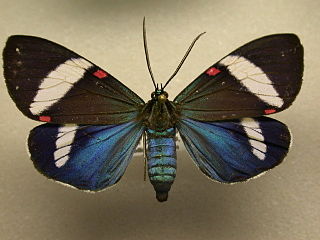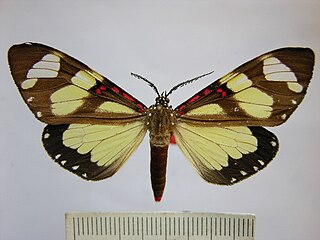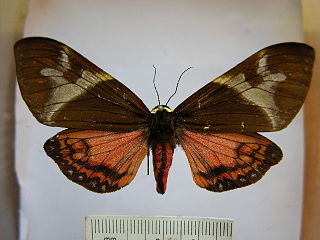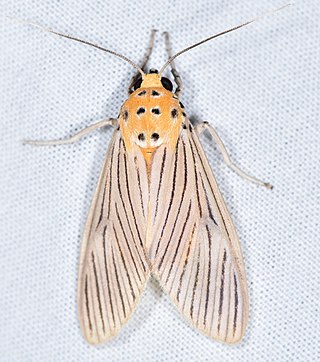Related Research Articles

Hypocrisias is a genus of moths in the family Erebidae erected by George Hampson in 1901.

Hypocrita is a genus of tiger moths in the family Erebidae. The genus was erected by Jacob Hübner in 1807.

Idalus is a genus of moths in the family Erebidae. The genus was erected by Francis Walker in 1855.

Phaloe is a genus of moths in the subfamily Arctiinae. The genus was erected by Félix Édouard Guérin-Méneville in 1838.

Pseudophaloe is a genus of tiger moths in the family Erebidae. The genus was described by Hering in 1925.

Virbia is a genus of tiger moths in the family Erebidae. The genus was erected by Francis Walker in 1854.

Cocytia is a genus of moths in the family Erebidae. It is monotypic, being represented by the single species, Cocytia durvillii, an uncommon day-flying moth found in lowland areas of the Moluccas, Aru, and New Guinea. The species has clear wings bordered with black, with an orange patch at the base of each forewing and long antennae, thicker at the outer end. Both the genus and species were first described by Jean Baptiste Boisduval in 1828.

Antichloris viridis, the satin stowaway or banana moth, is a moth of the family Erebidae. The species was first described by Herbert Druce in 1884. It is found in Colombia, Panama, Nicaragua and Venezuela. It has also been observed a number of times in Great Britain, after being accidentally imported in fruit consignments.
Coreura phoenicides is a moth of the subfamily Arctiinae. It was described by Herbert Druce in 1884. It is found in Guatemala and Costa Rica.

Dysschema leda is a moth of the family Erebidae first described by Herbert Druce in 1884. It is found in Costa Rica.
Dysschema forbesi is a moth of the family Erebidae first described by Herbert Druce in 1907. It is found in Brazil.

Dysschema lygdamis is a moth of the family Erebidae first described by Herbert Druce in 1884. It seems restricted to the mountains of Costa Rica and Panama.

Dysschema cerialis is a moth of the family Erebidae first described by Herbert Druce in 1884. It is found in Panama.
Josiomorphoides gigantea is a moth of the subfamily Arctiinae first described by Herbert Druce in 1897. It is found in Panama and Colombia.
Pseudophaloe schausii is a moth of the family Erebidae first described by Henry Edwards in 1884. It is found in Mexico and Guatemala.
Pseudophaloe promiscua is a moth of the family Erebidae first described by Vitor Osmar Becker and Espinosa in 2013. It is found in Costa Rica.

Phaeomolis lineatus is a moth of the family Erebidae. It was first described by Herbert Druce in 1884. It measures 31-36mm in length. It is found across Central and North America in Panama, Costa Rica, Honduras, Belize, Nicaragua, and Mexico.
Pseudophaloe cerealia is a moth in the family Erebidae. It was described by Herbert Druce in 1884. It is found in Panama.
Pseudophaloe helotes is a moth in the family Erebidae. It was described by Herbert Druce in 1884. It is found in Panama.
Pseudophaloe troetschi is a moth in the family Erebidae. It was described by Herbert Druce in 1884. It is found in Panama.
References
- ↑ Savela, Markku. "Pseudophaloe ninonia (Druce, 1884)". Lepidoptera and Some Other Life Forms. Retrieved September 6, 2019.
- ↑ Becker, Vitor O. (September 15, 2013). "Taxonomic changes in the Neotropical Pericopina and Ctenuchina moths (Erebidae, Arctiinae, Arctiini), with description of new taxa" (PDF). The Journal of Research on the Lepidoptera. 46: 53–66. Archived from the original (PDF) on December 24, 2013.